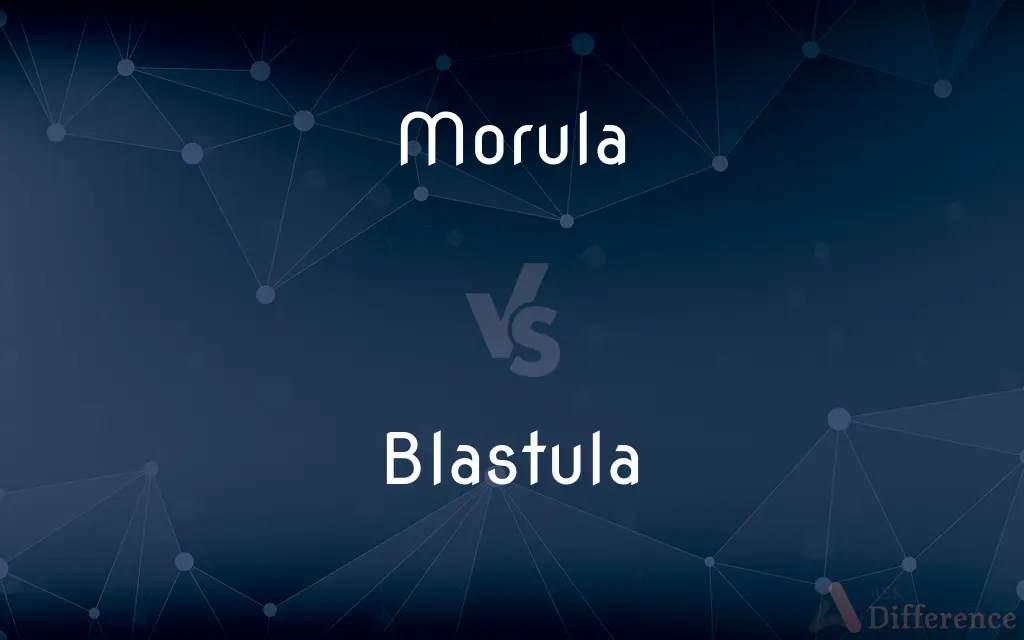Morula vs. Blastula — What's the Difference?
By Fiza Rafique & Maham Liaqat — Updated on March 15, 2024
The morula is an early stage of embryonic development, characterized by a solid ball of cells, while the blastula follows as a hollow ball of cells, indicating a key step in forming distinct cellular layers.

Difference Between Morula and Blastula
Table of Contents
ADVERTISEMENT
Key Differences
The morula stage represents an early phase in embryonic development, occurring after the zygote has undergone several rounds of cell division (cleavage). At this point, the embryo is a solid ball of cells, with no internal cavity. On the other hand, the blastula stage follows the morula, featuring a hollow structure with a fluid-filled cavity called the blastocoel. This transition marks a critical developmental milestone, as the blastula's structure sets the stage for later differentiation and the formation of the germ layers.
While the morula is compact and lacks internal spaces, the transition to the blastula involves a significant reorganization of cells. Cells in the blastula are arranged more loosely, allowing for the formation of the blastocoel. This cavity is not merely a structural feature but plays a crucial role in the embryo's subsequent development, including the process of gastrulation, where the blastula begins to form distinct layers. Meanwhile, the morula's dense arrangement of cells facilitates the initial stages of cellular differentiation, setting the groundwork for the embryo's further development.
The morula stage is critical for the early division and organization of embryonic cells, but it does not yet show the distinct cell layers or the internal organization characteristic of later stages. Conversely, the formation of the blastula signifies the embryo's readiness to undergo more complex differentiation processes, including the formation of the ectoderm, mesoderm, and endoderm, which are the foundational layers for all tissues and organs.
In many species, the transition from morula to blastula is also associated with changes in the embryo's metabolic activities and the initiation of gene expression patterns that will dictate future development. The blastula stage, therefore, not only showcases a physical transformation but also reflects a shift towards a more complex developmental program. While the morula relies on maternal mRNA and proteins stored in the egg, the blastula stage often marks the beginning of zygotic gene transcription, leading to the embryo's increased autonomy in its development.
Both stages are essential in embryology, representing key steps in the journey from a fertilized egg to a fully developed organism. The morula's formation lays the groundwork for cellular differentiation, while the blastula's structure and internal cavity are pivotal for the embryo's subsequent patterning and organ formation. Understanding the differences and connections between these stages is fundamental to grasping the complexities of embryonic development.
ADVERTISEMENT
Comparison Chart
Definition
Early embryonic stage characterized by a solid ball of cells.
Subsequent stage featuring a hollow ball of cells with a fluid-filled cavity.
Structure
Solid, with closely packed cells and no internal cavity.
Hollow, with a central fluid-filled cavity (blastocoel).
Developmental Significance
Represents initial cell divisions and compact cell arrangement.
Marks the formation of the blastocoel and preparation for germ layer formation.
Cell Organization
Cells are undifferentiated and equally sized.
Cells begin to show more organization and differentiation.
Role in Development
Sets the groundwork for cellular differentiation.
Facilitates further differentiation and the beginning of organogenesis.
Compare with Definitions
Morula
Represents the compact grouping of embryonic cells.
In the morula stage, cells are closely packed, resembling a mulberry.
Blastula
A stage in embryonic development featuring a hollow ball of cells.
The blastula is characterized by the presence of the blastocoel.
Morula
Indicates the beginning of embryonic development.
The formation of the morula is one of the first steps in embryonic development.
Blastula
Indicates the initiation of cellular differentiation.
The blastula stage sets the stage for the formation of germ layers.
Morula
Stage before the blastula.
The embryo transitions from the morula to the blastula stage as it develops.
Blastula
Contains a fluid-filled cavity called the blastocoel.
The blastocoel is a key feature distinguishing the blastula from earlier stages.
Morula
Lacks a fluid-filled cavity.
Unlike the blastula, the morula does not contain a blastocoel.
Blastula
Prepares the embryo for gastrulation.
The blastula's structure is crucial for the process of gastrulation to begin.
Morula
An early embryonic stage consisting of a solid ball of cells.
The morula forms after several rounds of cell division following fertilization.
Blastula
Follows the morula stage.
After the morula, the embryo rearranges into the blastula structure.
Morula
A morula (Latin, morus: mulberry) is an early-stage embryo consisting of 16 cells (called blastomeres) in a solid ball contained within the zona pellucida.A morula is distinct from a blastocyst in that a morula (3–4 days after fertilization) is a mass of 16 totipotent cells in a spherical shape whereas a blastocyst (4–5 days after fertilization) has a cavity inside the zona pellucida along with an inner cell mass. A morula, if untouched and allowed to remain implanted, will eventually develop into a blastocyst.The morula is produced by a series of cleavage divisions of the early embryo, starting with the single-celled zygote.
Blastula
An early embryonic form produced by cleavage of a fertilized ovum and consisting of a spherical layer of cells surrounding a fluid-filled cavity. Also called blastosphere.
Morula
The spherical embryonic mass of blastomeres formed before the blastula and resulting from cleavage of the fertilized ovum.
Blastula
(embryology) An early form in the development of an embryo, consisting of a spherical layer of cells filled with fluid; a blastosphere.
Morula
(embryology) A spherical mass of blastomeres that forms following the splitting of a zygote; it becomes the blastula
Blastula
That stage in the development of the ovum in which the outer cells of the morula become more defined and form the blastoderm.
Morula
The sphere or globular mass of cells (blastomeres), formed by the clevage of the ovum or egg in the first stages of its development; - called also mulberry mass, segmentation sphere, and blastosphere. See Segmentation.
Blastula
Early stage of an embryo produced by cleavage of an ovum; a liquid-filled sphere whose wall is composed of a single layer of cells; during this stage (about eight days after fertilization) implantation in the wall of the uterus occurs
Morula
A solid mass of blastomeres that forms when the zygote splits; develops into the blastula
Common Curiosities
Can the morula stage be observed in all animals?
While variations exist, the morula stage is a common early embryonic stage in many multicellular animals, including humans.
Why is the blastocoel important?
The blastocoel allows for cell migration and differentiation, essential for the formation of germ layers and subsequent organogenesis.
How does the morula transition to the blastula?
The transition involves cell rearrangement and the formation of a fluid-filled cavity within the embryo, marking the development from a solid to a hollow structure.
What is a morula?
A morula is an early embryonic stage consisting of a solid ball of closely packed cells, following several cell divisions after fertilization.
What happens after the blastula stage?
Following the blastula stage, the embryo typically enters gastrulation, where cells begin to form distinct layers, leading to the development of organs and tissues.
What defines the blastula stage?
The blastula is a stage in embryonic development where the embryo forms a hollow ball of cells with a central fluid-filled cavity, the blastocoel.
How are morula and blastula stages similar?
Both are early embryonic stages crucial for development, involving key processes of cell division and arrangement.
Why is the study of morula and blastula stages important?
Understanding these stages provides insights into early embryonic development, cellular differentiation, and the fundamentals of developmental biology.
Do all embryos form a distinct morula and blastula?
While most multicellular organisms go through these stages, the specifics can vary among different species.
What role does the morula play in development?
The morula stage is important for the early division and organization of cells, setting the foundation for further embryonic development.
Is the morula capable of gene expression?
Initially, the morula relies on maternal mRNA and proteins, but as development progresses, especially by the blastula stage, zygotic gene expression begins.
Share Your Discovery

Previous Comparison
Reference vs. Recommendation
Next Comparison
Aquaculture vs. PiscicultureAuthor Spotlight
Written by
Fiza RafiqueFiza Rafique is a skilled content writer at AskDifference.com, where she meticulously refines and enhances written pieces. Drawing from her vast editorial expertise, Fiza ensures clarity, accuracy, and precision in every article. Passionate about language, she continually seeks to elevate the quality of content for readers worldwide.
Co-written by
Maham Liaqat













































